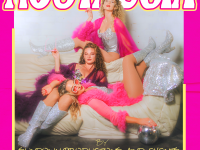
TRIPTYCH
Temperance Hall and FRAME: A biennial of dance
Temperance Hall and Phillip Adams BalletLab presents Triptych, a divine intervention of queer crucifixions inspired by Francis Bacon’s triptych paintings (1944–1986). Triptych celebrates the cultural kitsch of Christian spirituality and transforms its heteronormative iconography with a queer veneer. Now Melbourne will have the chance to see this transformative work during FRAME: A biennale of dance.
“The sensations crush together: arousal, alienation, disgust, ennui. Sexuality is here presented as performance, a scene with its own codes of dress and behaviour, indifferent to the outside world.” Matthew Westwood, The Australian
Since premiering this week at Phoenix Central Park for Sydney World Pride, Triptych has received impassioned responses from audiences:
“The space is sublime and the perfect environment for such an intimate performance. It was an incredible experience, thank you for your generosity and gift to the city.” 
“Brilliant to see a dance work respond to the site. Gorgeous confluence of dance, performance & installation. Fabulous use of dramatic text and critical text. Beautiful costumes & great performers. Really loved the show. Thank you.”
“This epitomises the reason I love Phoenix so much – being introduced to something so completely unique which questions your perspective on art! Such a transformative experience performed by such committed auteurs.”
Phillip Adams, Australian maverick of contemporary dance, creates choreographic abstractions of Bacon’s crucifixions: dancers enact duets of physical detachment and violent tremors that evoke the spectacle of horror – a distinguishing feature of Bacon’s oeuvre. Amidst a sphincter-sex-sling installation, performers portray Bacon’s theatrical and surreal imaginariums of the crucifixion in a Disney-esque balletic parody of the grotesque. Adams’ collaborators on Triptych are some of Australia’s most influential contemporary artists: visual artists Paul Yore and Devon Ackerman; fashion designer Toni Maticevski; composers David Chisholm and Duane Morrison; and video artist James Wright. These artists break with convention, make queer art and design with intelligence, and experiment with the sort of risk that gives way to unshakeable originality.
Over 25 years, Adams’ body of work has insisted on and argued for the visibility of queer aesthetics in Australian contemporary dance, performance and art. Triptych honours queer elders, histories and communities by exploring queer expression throughout art history as a reliable signifier of the ever-changing avant-garde.
Visual design
Created by Paul Yore and Devon Ackermann, the set for Triptych is drawn variously from depictions of domestic and cinematic space in the work of Bacon, particularly two Triptych works from 1970. The material and formal elements for the set are largely drawn from these paintings, in which modernist depictions of domesticity foreground a psychosexual depiction of the body that can openly be read as masculinist, queer, libidinal, violent, performative, grotesque and/or ambiguous. The set itself consists of three distinct elements, which also references what Bacon himself called the ‘balanced unit’ of the Triptych format.
Costumes
Australian fashion icon Toni Maticevski has built a brand, and vision that has defied trends and inspired contemporary women’s fashion and design for nearly two decades. Maticevski has collaborated with Phillip Adams BalletLab for two productions, Miracle (2009) and Aviary (2011) for which he won a Helpmann Award (shared with Milliner Richard Nylon.) For Triptych, Maticevski’s costume designs subvert Bacon’s exposed and disconfigured bodies through ornate bondage and suited attire: kinky-prince meets power-bottom adorned in designer jock straps.
Film
Triptych includes a film created and performed by Adams in collaboration with NON-Studio’s Director, James Wright. Adams’ works often include startling elements to shake an audience out of complacency. In Triptych, this tendency is made centrepiece, portraying the queer body as an unstable site of sublime beauty and abhorrence. The film, in which Adams performs a painterly choreographic expression atop a large-scale canvas using his anus as a brush, references the blood of Christ
“I read the rectum paint as ‘a font of creation’, an expression of deep privacy, a physicality we are conditioned from childhood to reject. In attending a crucifixion, one witnesses an act of ultimate judgement. In Triptych, I challenge the act of witnessing – by joining the dancers only on film, my presence seeps outside the frame of the live performance; in this intervention my fragmented presence becomes the omnipotent judge and the ultimately judged.” – Phillip Adams
Triptych for Frame: A biennial of dance
15th–18th March, 2023









